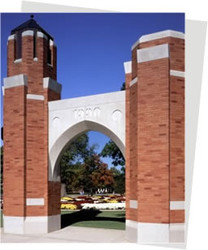|
A goldmine of intriguing campus facts |

#6 Centennial Arches
One of the first landmarks to greet students parading through the South Oval, the Centennial Arches might seem to be just another red-bricked yawn; however, they conceal mysterious cargo. The arches, a gift from the class of 1990, actually house a time capsule scheduled to be opened only in 2090.
Centennial Arches / The University of Oklahoma
The Centennial capsule contains a 1990 yearbook, a sports almanac, and a message from President Van Horn. As for the other contents, students and staff will have to wait until 2090 to find out!
#5 The ’06 Rock
The ’06 Rock on the North Oval was found by Class of 1906 students after the chunk of rock fell from a passing freight train. When the enterprising students attempted to transport the boulder back to campus via wagon, the crushing weight of the stone buried the wagon wheels into the ground.
Cooper Williams / Own Work
After hiring a stonemason to chisel their class’ graduating year onto the rock, the 1906 class proudly displayed their find on the campus lawn. However, the rival class of 1907 was quick to bury the makeshift monument in a nearby graveyard as a prank. The class of ’06 promptly poured a cement base for the rock, safeguarding against future mischief and securing its place on campus - figuratively and literally.
#4 The Monnet Hall Owl
Perched just below the roofline of Monnet Hall, an owl painted “engineering green” peers out from its niche. The bronze casted fowl commemorates the rivalry of pranks between OU’s Engineering and Law students—a legacy that continues to this day, although rival lawyers vacated the so-called "Law Barn" in 1976 for the new OU Law Center across campus.
Anthony Eversole / CC-BY-SA-2.0
Come out and find it: tag #oumonnetowl when you instagram it!
#3 The Seed Sower
The iconic statue of the Seed Sower is modeled after the university’s first president, David Ross Boyd, and represents the school’s dedication to sowing the seeds of knowledge and wisdom, which bear fruit in time. Boyd famously set aside half of his personal annual salary to buy, plant and water the trees on campus, which was barren prior to 1892.
Cooper Williams / Own Work
The Seed Sower is the most famous sculpture by native Oklahoman artist Paul Moore, but it isn’t his only addition to campus. The Seed Sower’s less-recognized cousins include the life-size bronze statue of OU President George Lynn Cross near Evans Hall, a likeness of Edward L. Gaylord facing the football stadium to the side the Gaylord College, and an oversized representation of 46th Speaker of the U.S. House of Representatives, Carl Albert, outside the Oklahoma Memorial Union.
#2 Spoonholder
Legend holds that any starry-eyed couple who share a kiss in the old campus fixture, nicknamed “The Spoonholder”, is destined to be married. Originally molded under the cover of darkness by the senior class and painted bright yellow by the rival junior class in the same night, the original landmark saw its own share of mischief before crumbling in-transit during the 1983 Parrington Oval renovation. Today's Spoonholder was rebuilt by the class of 1990 as their memorial project and includes pieces of the original landmark in its concrete.
Spoonholder / Holman's on the Horizon
Most explanations cite its rounded shape - similar to a household, stovetop spoonholder - as the primary inspiration for its colorful name. However, the name also comes from the 20th century reference to the practice of “spooning” (a term which formerly meant casually sitting with an arm around a girl), for which this spot was the campus favorite. Do you know any married couples that shared a kiss in the spoonholder?
#1 Lady Sphinx
Could this captivating figure be a majestic visage of ancient Greek glory reimagined? Or is this statue doomed to be remembered only as a bulbous, heaving cacophony for the eyes? Sphinx was sculpted by Columbian artist, Fernando Botero, and came to the University in 2004 through a provision to purchase one of Botero’s statues in the will of wealthy benefactor, Jerome M. Westheimer Sr.
Sphinx / by and by
Regardless of some students’ opinions, 2004 Fred Jones Jr. Director, Eric Lee, believes he choose the perfect Botero statue to complement the geometric pyramids and chalky limestone of the museum’s exterior. Do the Sphinx’s well-trimmed fingernails and apparently amicable expression evoke passions of endearing rapture or disenchanted disgust in passing viewers? Perhaps both. Generations of future students will carry on this legendary debate.
-----
Resources:
The Legend of the Spoonholder: The spirit of 1910 returns in a '90s sort of way
Regent's Notes Mentioning Restored Campus Landmarks
OU Daily's Quick Guide to Campus Sculptures
George Lynn Cross Statue (Seed Sower)
Paul Moore: A Legacy in Bronze








